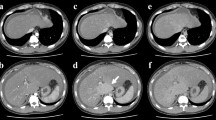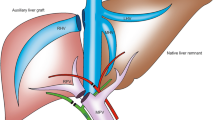Abstract
A 20-year-old woman was admitted to an emergency hospital after ingesting 66 g of acetylsalicylic acid in a suicide attempt. Although she was treated with gastric lavage, oral activated charcoal, and intravenous hydration with sodium bicarbonate, her hepatic and renal function gradually deteriorated and serum amylase levels increased. Steroid pulse therapy, plasma exchange, and continuous hemodiafiltration did not yield any improvement in her hepatic or renal function, and she was transferred to our hospital for living donor liver transplantation. Nine days after drug ingestion, she developed hepatic encephalopathy: thus, we diagnosed the patient with acute liver failure with hepatic coma accompanied by acute pancreatitis due to the overdose of acetylsalicylic acid. Living donor liver transplantation was immediately performed using a left lobe graft from the patient’s mother. Following transplantation, the patient’s renal and hepatic function and consciousness improved, and she was discharged. In this report, we describe a rare case of acetylsalicylic acid-induced acute liver failure with acute hepatic coma and concomitant acute pancreatitis and acute renal failure, which were treated successfully with emergency living donor liver transplantation.




Similar content being viewed by others
Abbreviations
- ALF:
-
Acute liver failure
- LDLT:
-
Living donor liver transplantation
- ASA:
-
Acetylsalicylic acid
- PT-INR:
-
Prothrombin time-international normalized ratio
- MELD:
-
Model for end-stage liver disease
- PE:
-
Plasma exchange
- CHDF:
-
Continuous hemodiafiltration
- WBC:
-
White blood cell count
- HB:
-
Hepatitis B
- T-bil:
-
Total bilirubin
- Cr:
-
Creatinine
- CT:
-
Computed tomography
- SLV:
-
Standard liver volume
- NSAID:
-
Nonsteroidal anti-inflammatory drug
References
Naiki T, Nakayama N, Mochida S, et al. Novel scoring system as a useful model to predict the outcome of patients with acute liver failure: application to indication criteria for liver transplantation. Hepatol Res. 2012;42:68–75.
Kawasaki S, Hashikura Y, Matsunami H, et al. Temporary shunt between right portal vein and vena cava in living related liver transplantation. J Am Coll Surg. 1996;183:74–6.
Urata K, Kawasaki S, Matsunami H, et al. Calculation of child and adult standard liver volume for liver transplantation. Hepatology. 1995;21:1317–21.
Uchikawa Y, Ikegami T, Masuda Y, et al. Administration of dalteparin based on the activated clotting time for prophylaxis of hepatic vessel thrombosis in living donor liver transplantation. Transplant Proc. 2009;41:3784–90.
Mochida S, Tkikawa Y, Nakayama N, et al. Diagnostic criteria of acute liver failure: a report by the intractable Hepato-Biliary Diseases Study Group of Japan. Hepatol Res. 2011;41:805–12.
Japanese Society for the study of Liver Transplantation. Reports on the registered cases for liver transplantation in Japan. Ishoku (Transplant). 2014;49:261–74 (in Japanese).
Zimmerman HJ. Effects of aspirin and acetaminophen on the liver. Arch Intern Med. 1981;141:333–42.
Chan TY. The risk of severe salicylate poisoning following the ingestion of topical medicaments or aspirin. Postgrad Med J. 1996;72:109–12.
McGuigan MA. A two-year review of salicylate deaths in Ontario. Arch Intern Med. 1987;147:510–2.
Trost LC, Lemasters JJ. Role of mitochondrial permeability transition in salicylate toxicity to cultured rat hepatocytes: implications for the pathogenesis of Reye’s syndrome. Toxicol Appl Pharmacol. 1997;147:431–41.
Corey L, Rubin RJ, Hattwick MA, et al. A nationwide outbreak of Reye’s syndrome. Its epidemiologic relation of influenza B. Am J Med. 1976;61:615–25.
Cag M, Saouli AC, Audet M, et al. Reye syndrome and liver transplantation. Turk J Pediatr. 2010;52:662–4.
Brown RE, Johnson FB, Mullick FG. Hepatic lipid in Reye’s syndrome: histochemical and ultrastructural characteristics. Pa Med. 1974;77:39–41.
Bove KE, McAdams AJ, Partin JC, et al. The hepatic lesion in Reye’s syndrome. Gastroenterology. 1975;69:685–97.
Starko KM, Mullick FG. Hepatic and cerebral pathology findings in children with fatal salicylate intoxication: further evidence for a causal relation between salicylate and Reye’s syndrome. Lancet. 1983;1:326–9.
Fontana RJ, McCashland TM, Benner KG, et al. Acute liver failure associated with prolonged use of bromfenac leading to liver transplantation. Liver Transpl Surg. 1999;5:480–4.
Hanau C, Munoz SJ, Rubin R. Histopathological heterogeneity in fulminant hepatic failure. Hepatology. 1995;21:345–51.
Depla AC, Vermeersch PH, Van Gorp LH, et al. Fatal acute liver failure associated with piprofen. Report of a case and review of the literature. Neth J Med. 1990;37:32–6.
Fraser JL, Antonioli DA, Chopra S, et al. Prevalence and nonspecificity of microvesicular fatty change in the liver. Mod Pathol. 1995;8:65–70.
Mallory A, Kern F Jr. Drug-induced pancreatitis: a critical review. Gastroenterology. 1980;78:813–20.
Cabooter M, Elewaut A, Barbier F. Salicylate-induced pancreatitis. Gastroenterology. 1981;80:214.
Miltiadous G, Anthopoulou A, Elisaf M. Acute pancreatitis possibly associated with combined salicylate and atorvastatin therapy. JOP. 2003;4:20–1.
Wedgwood KR, Adler G, Kern H, et al. Effects of oral agents on pancreatic duct permeability. A model of acute alcoholic pancreatitis. Dig Dis Sci. 1986;10:1081–8.
Huerta C, Castellsague J, Varas-Lorenzo C, et al. Nonsteroidal anti-inflammatory drugs and risk of ARF in the general population. Am J Kidney Dis. 2005;45:531–9.
Murray MD, Brater DC. Renal toxicity of the nonsteroidal anti-inflammatory drugs. Annu Rev Pharmacol Toxicol. 1993;33:435–65.
Matsunami H, Makuuchi M, Kawasaki S, et al. Living-related liver transplantation in fulminant hepatic failure. Lancet. 1992;340:1411–2.
Disclosures
Conflict of Interest:
Tomoki Shirota and co-authors have no conflict of interest
Human/Animal Rights:
All procedures followed were in accordance with the ethical standards of the responsible committee on human experimentation (institutional and national) and with the Helsinki Declaration of 1975, as revised in 2008(5).
Informed Consent:
Informed consent was obtained from all patients for being included in the study.
Author information
Authors and Affiliations
Corresponding author
Rights and permissions
About this article
Cite this article
Shirota, T., Ikegami, T., Sugiyama, S. et al. Successful living donor liver transplantation for acute liver failure after acetylsalicylic acid overdose. Clin J Gastroenterol 8, 97–102 (2015). https://doi.org/10.1007/s12328-015-0553-3
Received:
Accepted:
Published:
Issue Date:
DOI: https://doi.org/10.1007/s12328-015-0553-3




